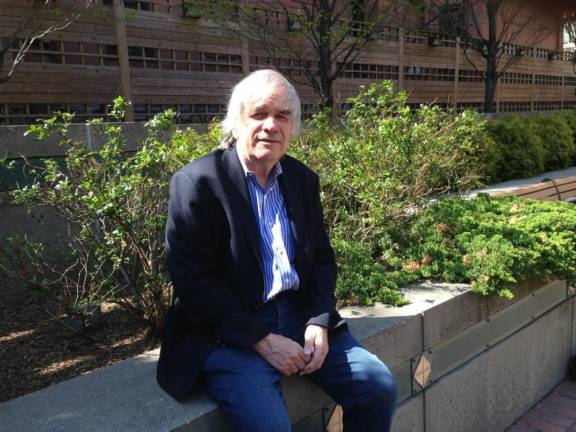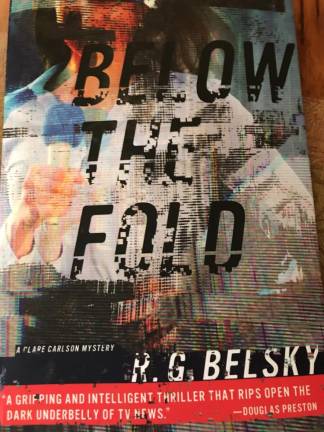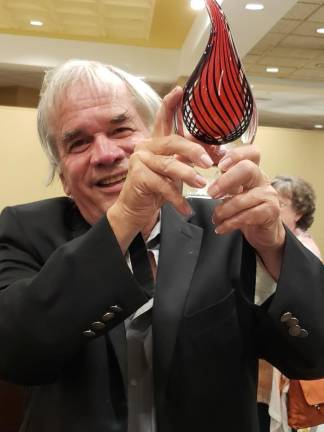Deadline NYC
R.G. Belsky decamped from the high-stakes world of big media to write suspense novels offering a behind-the-scenes look at – you guessed it – the high-stakes world of big media.
It was 1989 when Dick Belsky was fired as metro editor of the New York Post. I know: I walked him out the door that day. Then in 2005, he left his post as Daily News managing editor. I had changed newspapers, too, there was a tradition to uphold, so again, I walked him out. That’s by way of saying he’s a great friend, mentor, editor, ex-boss and commanding newsroom presence. Still, I never could have predicted that after a career that also took him to Star Magazine and NBC News, he’d reinvent himself as R.G. Belsky, award-winning mystery novelist. His ripped-from-the-headlines style, however, shows he never really left the business he’s loved since 1970, when he was discharged from Army intelligence, left Vietnam and walked into the Post City Room.
Belsky is the author most recently of “Below the Fold,” newspaper lingo for a story not juicy enough to merit Page 1 play atop the page. The thriller, which dissects a homeless woman’s seemingly obscure murder, is the second in a planned trilogy featuring hard-driving, thrice-divorced TV news director and newspaper veteran Clare Carlson, who debuted in “Yesterday’s News,” winner of Deadly Ink’s David Award for best mystery of 2018. With Clare set to return in May in Belsky’s 14th novel, “The Last Scoop,” we chatted about media, murder, news, novels, and the most famous headline in tabloid history.
You switched from covering real-life crime to creating fictional crime mysteries. Any cultural shock?
The biggest problem I had was unlearning many of the things I’d done as a tabloid journalist who has to tell the story in a hurry. Get the main facts up high, put the five W’s – who, what, where, when and why – in the first paragraph. But you can’t put all the facts on the first page of a mystery! I was getting from A to B too fast when I started writing crime fiction. That’s great for a journalist. Not so great for a mystery author.
What was the transition like? And why did editor Dick Belsky rebrand as mystery writer R.G. Belsky?
Messy and seamless both, I guess. I started writing my first mystery novel in 1978 – but didn’t get it published until 1985. Since then though I’ve published 12 more. The early ones actually do use the name “Dick Belsky.” But at one point in the ‘90s, a publisher decided to rebrand me as “R.G. Belsky.” The reasoning was the reader wouldn’t know if I was a woman or a man who was writing a woman’s character. But this cleverly thought-out plan fell apart when they included a picture of me on the book jacket! Nevertheless, I’ve been R.G. Belsky as an author since then.
You moved from writing in newsrooms to writing in ... Well, where do you write?
Everywhere. In New York City coffee shops, subways, bars, park benches, pretty much everywhere else you can think of. I also write at The Writers Room in the East Village and the main New York Public Library. I need to be around people when I’m writing. I love the noise and the chaos of the city, it inspires me. Probably because I’ve spent much of my life writing in loud and chaotic news rooms.
You’ve lived in Gramercy Park since 1973. Why not simply write from home like most fellow authors?
My apartment is the only place where I never write. Too many distractions. TV, household tasks, the bed for a nap. So I leave my home every morning just like I was going to an office and write out in the city. Seems strange for some people, but it works for me.
What’s with the yellow-lined legal pads? You don’t really write books in longhand, do you?
I do. And I’m not sure why. All the years I was writing news stories I did them on a computer in the newsroom. But there’s something about writing fiction that feels more comfortable for me to create that imaginary world with a pen and a legal pad. I write very quickly, and then edit it once I put it onto my computer or iPad. Just for the record, Ernest Hemingway used to write descriptive passages in longhand too, then used a typewriter for the dialogue. Not comparing myself to Hemingway, but he’s not a bad writer to emulate, right?
Tell me about Clare Carlson, the protagonist and first-person narrator of “Below the Fold.”
Clare is a compilation of a lot of terrific journalists, many of them women, I’ve worked with in my career. Talented, outspoken, gets herself in trouble and pushes the boundaries of right and wrong a lot. But also brings an admirable integrity to her job, like many of my favorite fictional mystery characters, Philip Marlowe, Harry Bosch or Kinsey Millhone.
She’s got three busted marriages, a stormy personal life, plenty of flaws. Why does the reader care?
Would you want to read a story about a character who was perfect in every way – happy marriage, wonderful children, successful in every aspect of life? I wouldn’t ...We love “flawed” characters, and Clare has lots of flaws. Basically, she’s a terrific journalist – the rest of her life is a train wreck. I’ve known a lot of people like that in the pressure-packed, fast-moving media world. I think her flaws make Clare more likable and keep people turning the pages.
One of your themes is the inequality of murder, the “Blonde White Female Syndrome.” Does Clare shatter that paradigm?
I deal in this book with the perception that the media usually focuses on high-profile crimes involving sex, money and celebrity – O.J., JonBenet, Casey Anthony – ignoring the majority of other murders. Which is absolutely true. Clare breaks the rules this one time and investigates the seemingly unimportant murder of a homeless woman on the streets of New York. “Everyone has a life,” she reasons, “let’s find out what this woman’s life was all about.” The results turn into a sensational story.
Clare tells her story as a first-person female narrator and eight of your 13 novels use similar artistic gender-bending. Why?
I wish I could say it was a well thought-out plan. It isn’t. I find it more interesting to write women characters ... I also prefer writing books in the first person to get into the main character’s head. The Clare Carlson character started out with me writing her in the third person, but I found it more powerful when I changed Clare to first person.
Spectacular killings – Etan Patz, Son of Sam, John Lennon – seem to inspire your books. Made-for-tabloid murders are still in your blood?
Of course. I’ve covered so many high-profile crimes like that in my tabloid journalism career. People always ask mystery authors where they get their plot ideas. My answer is: “Hey, I just went to work in the newsroom every day.”
Which offers the greater thrill: Ripped-from-the-headlines fiction or covering the blood-soaked stories behind the headlines?
I love them both ... To me the two jobs were completely different. As a journalist, much of my day was consumed by getting facts, checking facts, making absolutely sure everything I put into print was totally accurate. As a mystery novelist, I get to make up the facts! Now that’s fun!
Finally, “HEADLESS BODY IN TOPLESS BAR,” the greatest tabloid headline ever written. What was your role in that 1983 Post story?
It’s probably the thing I’m most famous for in my journalism career (Google me with that headline). I didn’t write it, but I played a key part in the events of that day. My boss Vincent Musetto came up with the idea after a man was decapitated during a robbery of a Queens bar. Great headline, but no one was sure if it was topless or not. I had to confirm that before we could run the headline. I assigned a team of reporters in a desperate effort to find out before our deadline. One of them, a woman reporter named Maralyn Matlick, eventually crawled up onto a garbage can, peered in a back window of the place and saw a sign: “Topless dancing tonight.” And just like that, tabloid history was made. It’s become the most famous tabloid headline ever, “The Night of the Living Dead” of newspaper headlines.
invreporter@strausnews.com


